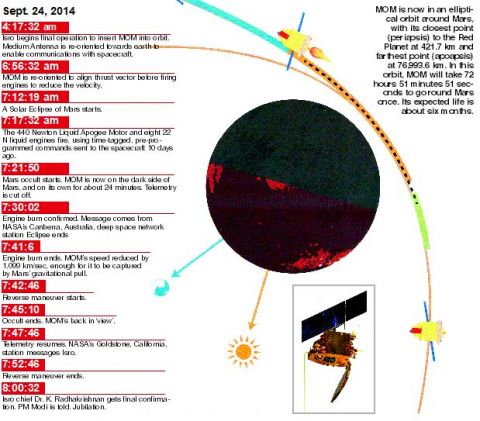Bengaluru :
Looking overjoyed, Prime Minister Narendra Modi, who was clapping persistently till he moved to make the announcement, was effusive in his praise of ISRO scientists for making India the “first” country to succeed in its maiden attempt to reach the Red Planet. Addressing scientists and engineers of ISRO at its Telemetry, Tracking and Command Network (ISTRAC) facility here said the organization has achieved the “near impossible,” and prevailed though the “odds were stacked against us.” “Of the 51 missions attempted across the world so far, a mere 21 have succeeded. But we have prevailed.” Indian scientists, through their hard work and dedication, had stretched the boundaries of human enterprise and imagination. He described the Mars Orbiter Mission (MOM) as an indigenous pan-Indian effort, stretching from Bengaluru to Bhubaneswar, and Faridabad to Rajkot.
Mr. Modi said the efforts of India’s space scientists are deepening governance, strengthening the economy and improving lives. “ We have dared to reach out into the unknown. And have achieved the near impossible. Travelling a mind-boggling distance of more than 650 million, or 65 crore kilometres, we have gone beyond the boundaries of human enterprise and imagination. We have, accurately navigated our spacecraft, through a route known to very few,” he added.
Recalling former Prime Minister A B Vajpayee’s vision twice during his speech, Mr. Modi said it was his vision which led to the launch of Chandrayaan-I and which in turn led to the mission to Mars.
“Through your achievements, you have honoured our fore-fathers and inspired our future generations,” he told the space scientists.
MOM Team Proud, Satisfied
This was not the sole achievement of the day, for the colour camera onboard Mangalyaan took five pictures of Mars, which would be received at Indian Deep Space Network (IDSN) facility near Bengaluru later today. “It is as good as being told that I am the father of a child. These pictures will convince tax payers that the expenditure on Mangalyaan is acceptable,” Dr. Ashutosh Shyamsingh Arya, principal investigator for the colour camera and a scientist at Space Applications Centre (SAC), Ahmedabad, told Deccan Chronicle. Besides beaming pictures of Martian soil and movement of sand dunes on the planet back to ISRO, the colour camera would be used to send out pictures of comet Siding Spring during its fly-by in October 2014.
For Mrs. Neelavathi, head of the team from ISRO’s Satellite Centre (ISAC), Bengaluru, which assembled transmitters for Mangalyaan, it was total satisfaction as systems designed by them worked flawlessly. “We are happy that the systems functioned as predicted and that the spacecraft has reached the right orbit,” she said.
As for the question about how Mangalyaan would help scientists, Prof. Jitendra Nath Goswami, Director, Physical Research Laboratory (PRL), Ahmedabad said the instruments onboard could answer questions on evolution of Mars and the universe, and the million-dollar-question of life on that planet. “The results will certain be the icing on the cake of this great achievement,” he told Deccan Chronicle.
The Orbiter, says Dr. S. K. Shivakumar, Director, ISAC, is in “extremely good health” after entering its orbit. “We saw good synchronization of all systems and therefore we are very happy with the performance of Mangalyaan,” he said.
source: http://www.deccanchronicle.com / Deccan Chronicle / Home> Technology> Science and Trends / DC / by B. R. Srikanth / September 25th, 2014
